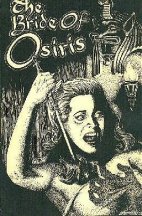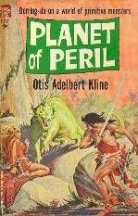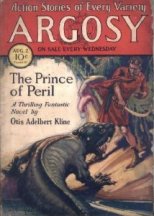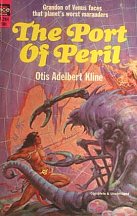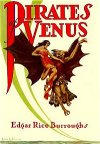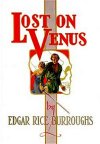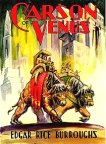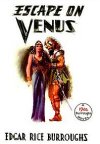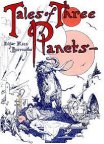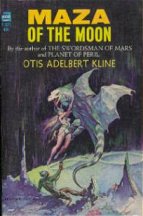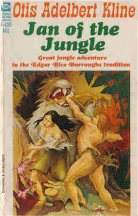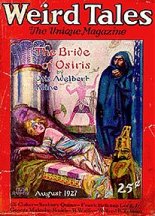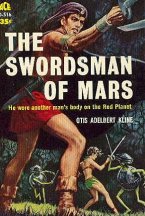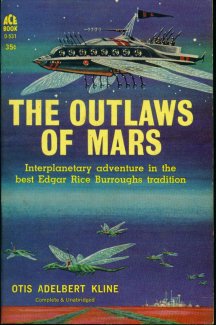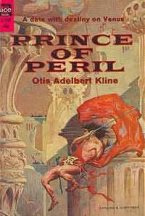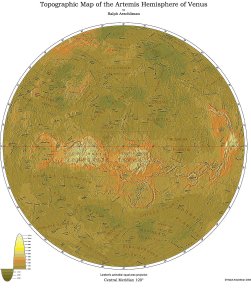Kline's Venus by Den Valdron (original) (raw)
CONTENTS
(16,780 Words)
INTRODUCTION
[_PRINCE OF PERIL_ - SYNOPSIS](#PRINCE OF PERIL -)
[_PLANET OF PERIL_ - SYNOPSIS](#PLANET OF PERIL -)
[_PORT OF PERIL_ - SYNOPSIS](#PORT OF PERIL -)
[_A VISION OF VENUS_ - SYNOPSIS AND DISCUSSION](#A VISION OF VENUS - SYNOPSIS AND)
[_THE BIRD PEOPLE_ - SYNOPSIS AND DISCUSSION](#THE BIRD PEOPLE - SYNOPSIS AND)
[THE GEOGRAPHY OF KLINE'S VENUS](#THE GEOGRAPHY OF KLINE'S)
[Prince of Peril ](#Prince of Peril)
[Planet of Peril](#Planet of Peril)
[Port of Peril](#Port of Peril)
[The Bird People ](#The Bird People and Vision of)[and_A Vision of Venus_](#The Bird People and Vision of)
MATCHING ZAROVIA
[The Bright Map](#The Bright)
[The Green/Blue Map](#The Green/Blue)
[Dirty Brown Maps](#Dirty Brown)
Viktor�s Map
[MATCHING KLINE�S ZAROVIA TO BURROUGHS AMTOR](#MATCHING KLINE�S ZAROVIA TO BURROUGHS)
[A Question of Respect](#A Question of)
[How is the Fit?](#How is the)
[What about Contact?](#What about)
[Geography and Demographics](#Geography and)
[Technology and Weapons](#Technology and)
Universal Languages?
[Thor and Thorther](#Thor and)
[Amphibians and Angans, Biology is Relativity](#Amphibians and Angans, Biology is)
[References to Overlaps](#References to)
INTRODUCTION
Mars gets all the attention for some reason, not just for Barsoom, but for many writers of Burroughs era like C.S. Lewis, Matthew Arnold and H.G. Wells. Indeed, Barsoom lives on, and a number of modern writers have written stories or novels merging these fictional Mars. I've played with this idea, writing a series of essays that locates Barsoomian geography, and many other fictional Martian landscapes on the geography of real Mars.

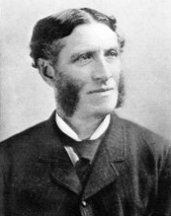

Lewis ~ Arnold ~ Wells
By contrast, Venus is a sort of poor sibling. For some reason, its never quite captured the imagination of writers or fans the way Mars did. One proof of this, is that we don't see the same sort of crossover pastiches for fictional Venuses, in the same way we find fictional Mars crossing over.
Hence, Burroughs Venus stories stand alone. Carson Napier never meets Tarzan, he doesn't encounter anything like Wells' tentacled Martian invaders, never meets a Venerian equivalent of Gulliver Jones.
However, there is at least one major writer who wrote adventures of Venus, who deserves a bit of scrutiny: Otis Adelbert Kline.
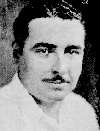 Kline was a pulp writer of the 1920s and '30s, who was in many ways a contemporary and a rival of Burroughs. Nowadays, his reputation rests largely on the similarity of his jungle and interplanetary books to those of Burroughs, and on stories of a supposed rivalry and competition between the two writers.
Kline was a pulp writer of the 1920s and '30s, who was in many ways a contemporary and a rival of Burroughs. Nowadays, his reputation rests largely on the similarity of his jungle and interplanetary books to those of Burroughs, and on stories of a supposed rivalry and competition between the two writers.
This is rather unfair. Kline was more than simply an imitator of Burroughs, that implies an inferior imitation. It would be better to say that Kline was a peer of Burroughs. His novels are right up there, toe to toe, eye to eye. He's generally better than Burroughs worst, not surprising since Burroughs was so much more prolific, and his best is close to Burroughs own best. Moreover, Kline's range diverted a bit from Burroughs, since he also seemed to write �Weird Tales� and Lovecraft-inspired stuff. Kline had a fairly diverse career, while Burroughs was mainly a writer, Kline was a publisher, editor, agent, songwriter, composer and music publisher.
In short, there was a lot more to Kline than simply being a Burroughs clone, or even being the best of the Burroughs clones. An appellation of this sort diminishes the man, and diminishes what must have been a rich and worthwhile life.
On the other hand, the twenties and thirties were full of very good and very worthy pulp writers. Any age is filled with good and worthy writers and artists. How many of them do we remember now? People say that art is permanent, but my own impression is that most art, apart from a few lucky lottery winners, is fleeting and impermanent. The stuff that endures for a while is partly brilliance, partly luck, partly extraordinary volume. Most is simply forgotten.
Edgar Rice Burroughs has endured, part of this is the quality of his writing, no question. Whatever criticisms exist, for the most part it is very good stuff, exciting and eminently readable. Part of this is his extraordinary volume, over 25 Tarzan books, eleven Martian books, seven Pellucidar novels, five Venus stories, a trilogy of Moon and Caspak stories and many odds and ends. You can fill a couple of shelves with Edgar Rice Burroughs. Part of this is luck, the fact that the Tarzan franchise took off in movies and television, the fact that he was writing in a particular time, the fact that he had a literary bounce after his death.
But Burroughs had a lot of contemporaries who are now mostly forgotten. I suppose Schubert and Chopin had brilliant contemporaries now forgotten, classical prodigies with smaller outputs or less fortunate circumstances. That's just fate.
And so we come back to Otis Adelbert Kline, who could have and perhaps should have been just another forgotten writer of a bygone era, and he manages to get a small slice of literary immortality through his connection to Burroughs. Well, I suppose its hardly fair to Kline. But then, without that connection, he might not be remembered at all. So, that's life.
I've previously written about Kline in the �Mighty OAK of Barsoom� essays, and I'd suggest you go there and check them out. Those essays focused on Kline's available Martian novels and fitting them into the Barsoomian tapestry.
Here, though, let us turn to Venus. And actually, its sort of interesting, because if Kline is sometimes accused of borrowing Barsoom. Then this time, it's Burroughs who can be accused of making off with Kline's Venus. Kline wrote his Venus stories first, so if there are any similarities, then the borrowing is going the other way.
Like Burroughs, Kline seems to have been a methodical writer, at least in terms of attention to detail and world building. Neither of these guys was making their planets up out of whole cloth, rather, they were working with the astronomical knowledge of the time, throwing in biology, anthropology and various disciplines. A nice example of this occurs in the Venus books, as his characters move up or down elevations, the nature of the vegetation changes. It's a throwaway bit, but impressive in its way.
According to the introduction of a collection called Bride of Osiris, Kline originally wrote his first Venus novel way back in 1922, although the Planet of Peril was not published until 1929. It featured the adventures of one Robert Grandon.
This was followed up in 1930 with _Prince of Peril_featuring a Harry Thorne, or Borgen Thakkor, it gets complicated. Then in 1933 he published Port of Peril bringing back Robert Grandon. In addition, there was a 1930 story called �The Bird People�, as well as a short story titled �Vision of Venus� from 1933, which will be covered here.
Finally, there's material that I haven't seen, but which is referred to, is 1933's Volunteers of Venus which was a collaboration with E. Hoffman Price. It's possible that Kline had other Venus stories and novellas, but its impossible to tell merely from the titles in his bibliography.
Edgar Rice Burroughs' Venus series comes much later. His first book, Pirates of Venus is from 1934. Lost on Venus is from 1936. Carson of Venus is from 1939. A fourth Venus book, Escape from Venus is actually a collection of four novellas from 1946, and a fifth novella, _Wizard of Venus_was discovered after his death.
So, clearly, Kline got to Venus first. And interestingly, Kline's output on Venus, three novels and at least three novellas or short stories, rivals Burroughs three novels and five novellas, and is perhaps, arguably better. In short, he's entitled to equivalent stature here.
The trouble with Kline though, is that he's gotten hard to find. You can find several of Burroughs novels on the web in public domain. Not so with Kline, in fact, the diligent searcher will discover only two Kline short stories �Stolen Centuries� and �Vision of Venus� on the internet. You can find just about all of Burroughs works summarised on the web, but only _Jan of the Jungle_for Kline.
Further, Kline seems to have been out of print since the 1960's, while Burroughs printings are still going strong. Of the stuff that was in print in the '60s, it seems to have been a couple of short stories in anthologies, Jan of the Jungle, Tam, Son of the Tiger, Maza of the Moon, and the Mars and Venus books. You can still obtain these books by searching used bookstores or going to Abebooks on the internet, and except for Tam, Son of the Tiger, the prices are relatively reasonable (though fees and shipping charges will kill you). But it's obviously harder. Further, most of Kline's other stuff seems lost forever, you'd have to go and collect the original pulps that they appeared in, and that's going to be a major effort.
It's a shame, because a lot of it is quite good, and it deserves a chance to find a new generation of readers. It's possible that if the John Carter of Mars movie succeeds, there'll be a bounce for Barsoom novels, and an opportunity for Kline's work to be republished once again. I'd certainly welcome that.
But in the meantime, its hard to find. I bought the two Martian novels through the internet, and Bill Hillman generously loaned me his copies of Kline's three Venus novels, as well as Jan of the Jungle, Maza of the Moon and Bride of Osiris.
So, as a courtesy to my readers, who may not be as lucky, patient or well off as to have or be able to easily obtain their own copies, but who find these sorts of articles interesting, I've decided to synopsize the novels and stories. I know this sort of treads on the material and might not make the copyright owners happy, but on the other hand, you do sort of have to be able to know what the novels are about to make sense of the essay. And in the long run, I think that anything that promotes interest in Kline is all to the good.
(One small note: If you read my discussions in �Mighty OAK of Barsoom� you'll notice some discrepancies there in terms of what I had to say about the Venus novels. I was going on secondhand information then, and simply got it wrong then. Thanks to Bill Hillman, I've had the chance to read the books now.)
So, read on....
PRINCE OF PERIL - SYNOPSIS
The novel opens with an introduction by the author discussing the character of Doctor Morgan. We're told that Doctor Morgan is a real person, although Morgan is not his real name. Kline meets Morgan while injured out in the countryside. As he gets to know Morgan, the Doctor shares with him the manuscripts of Harry Thorne, Jerry Morgan and Robert Grandon. The two discuss Edgar Rice Burroughs and John Carter, while noting that what was known then of Mars made those stories impossible. Morgan trots out his time travel thing.
Its an interesting and puzzling introduction. I have no idea why Kline has decided to mess with Doctor Morgan's identity. I'm almost inclined to suspect that Kline is giving a nod to some other pulp hero, perhaps under the pseudonym, Doctor Morgan is really Doc Savage or Professor Challenger. The matter may be grist for a Wold-Newtontype of examination.
Also interesting is the direct allusion to both Burroughs and John Carter. Indeed, we've got weird metafictional stuff rolling around here. Kline is copying Burroughs introductions for his Martian books, in which typically, the story is relayed to Burroughs, creating a kind of chain of plausibility: The hero relates his tale directly or indirectly to the author who relates it to the public. Here, Kline finally fills in his last link. The heroes relate their tale through Doctor Morgan who relates it to the author, who relates it to the public.
But there's something more here, in acknowledging John Carter's adventures are known, and known in the same way that Thorne and Morgan's adventures are known, and in using time travel to dodge around the obstacle of a dead Mars, Kline's fictional altar ego is coming very close to acknowledging the reality of Burroughs creations in the same universe as his own. In essence, if John Carter lives or lived, he did it on the same Mars that Kline's characters live or lived on, and possibly by the same transposition in time.
Finally, of course, there's an effort to explain that while Harry Thorne goes to Venus, it's a different Harry Thorne than the hero of Swordsman of Mars. In Swordsman of Mars, Harry Thorne of Earth exchanges bodies with Borgen Thakkor. Borgen Thakkor then winds up on Earth for ten years as Doctor Morgan's assistant, using Harry Thorne's identity. Eventually, Borgen gets bored and decides to try his hand at Venus.
Of course, this poses a problem for the reader. It appears that within the chronology of the Ace book reprints, published around 1960,Swordsman of Mars came first, followed by Outlaw of Mars, and then comes_Planet of Peril_ and Prince of Peril. However, the reality is that the Venus books came first. Planet of Peril was originally written in 1922 and published in 1929. Prince of Peril came the next year. The Mars books did not come about until 1933.
So, what's going on? Did Kline have it all mapped out in his head originally, and just had it published or written out of order? Did Kline rewrite and re-order after the books were published? Or is this continuity the result of an intervening editor or agent? Who knows. All I've got is the Ace books and a mystery. If there's an OAK fan out there with the answers, we'd love to hear about it.
But anyway, to the plot. Borgen Thakkor/Harry Thorne winds up getting transmitted to Mars. Unlike the other Venus novels, this one is written in first person narrative, giving it an immediate flavour much like Burroughs Barsoom novels.
Thorne winds up in the body of Prince Zinlo, of Olba. Olba seems to be a moderate sized Island nation, perhaps the most technically advanced society on Venus. Olba is unique in being the only Venerian nation which has mastered heavier than air flight, and it intends to keep that secret.
Alas, not all is well in Olba. A powerful nobleman, Taliboz, wants the throne, and is prepared to go through Zinlo to get it. Thakkor winds up fighting off nonstop assassination attempts, which culminate eventually, in a full fledged assault. Thakkor must flee in an airship, but the damaged ship goes out of control, dumping him in the ocean a thousand miles from home.
Luckily, Thakkor is able to get to land. There, he overhears a fight between a beautiful Princess, Lorali, and her suitor (and cousin) Gadrimel. Thakkor intervenes, kicking Gadrimel around and making introductions. Suddenly, Taliboz appears out of nowhere, kidnaps Lorali and flees.
Are you shocked? I'm shocked. I have no idea why Taliboz would want to do something like this. It seems motiveless, put it down as part of general villainy. Politically, it seems like a bad move, since Lorali is the daughter of Ad of Tyrhanna, who has the most powerful navy on the planet, and her fiancé is the son of Aardvar of Adonijar, whose navy is the second or third most powerful on Venus.
Well, the chase is on. Taliboz flees on an airship, but its shot down in the harbour. He commandeers a sailing ship and makes for home. Aardvar, Gadrimel and Thakkor take off after him with a fleet. The chase goes on for several days, finally winding up on a southern coastline.
It turns out that this section of coast is occupied by giant, cannibal ape-men. Thakkor gets lost and captured by the ape-men. He discovers that Lorali and Taliboz are also captured. Normally, humans are eaten, but if you're clever and entertaining, they'll keep you alive. Thakkor uses sleight of hand to impress the locals. But things are looking decidedly Kongish, the king of the ape-men, a twelve foot tall bruiser, decides to take Lorali for his bride.
Well, luckily, Thakkor has extraordinary martial arts and fencing skills, and is able to use his abilities to defeat the king, thereby becoming the new king of the ape-men. The dastardly Taliboz escapes however, kidnapping Lorali once again. Thakkor goes on the hunt with the best of the Ape-men trackers, and they hunt Taliboz down.
But then, his tracker decides to kidnap Lorali for himself. And at this point, I have to wonder, what is the problem with this girl? Does she have an �abduct me� sign taped to her back? Every time we turn around, she's being kidnapped. Gray space aliens would have to get in line to abduct this woman.
Thakkor tracks them both into a swamp where the ape-man is being eaten by giant leeches. The couple spend the day on a giant toadstool fighting off leeches and getting to know each other, before they manage to escape.
Then, the most amazing thing happens. Lorali develops a personality. She shows wit, humour, she's got gumption. She banters. Thakkor makes her a bow and arrow, and she spends time practicing with it. In short, she acts like a partner, a person, rather than a feminine handicap. Throughout the rest of the book, she continually shows courage and initiative, has her own ideas, and displays remarkable skills and abilities. She becomes an engaging and likable character, and for once, the romance with Thakkor develops naturally and feels right.
But anyway, from there, they make their way through the forest, eventually encountering a group of mechanical men. These men look and act human, except that they're androids. Taken to the androids city, they discover that it is a renegade colony of Olbans who have figured out a way to achieve immortality by transferring their minds into mechanical bodies. But after thousands of years of mechanical perfection, they want to get all fleshy if you know what I mean.
Well, neither Thakkor nor Lorali are into appliance based sex, so they decide to escape, and travel down the river to the coast, where they're captured by Prince Gadrimel. Gadrimel takes Lorali off with him (who wasn't expecting that?) and leaves orders for Thakkor to be executed.
But in the nick of time, the Ape-men show up to rescue Thakkor. It seems that they've come after him because he's now their king, and as a king, he's got duties that he needs to attend to. Like judging ape-men disputes. The disputes and arguments have been piling up and they really need some judging done.
Thakkor persuades them to help him rescue Lorali. They're pretty reluctant, could he perhaps do some judging first? But eventually he wins them over by promising they can eat Gadrimel�s men.
On this second encounter, I have to say that the ape-men are pretty entertaining. The first encounter, they were mostly big shaggy critters. But here, they've got a point of view. They want Thakkor to fulfill his responsibilities and do some judging. What can I say, it just works.
Thakkor gets out of it by appointing a judge of the ape-men, who is none too happy about the job. Then he escapes with Lorali in a boat. It turns out that Lorali, being the daughter of a sea lord, can both sail and fight at sea better than Thakkor can. But to no avail, they get sunk.
In the nick of time, they're rescued by an Olban sky craft, who takes them home.... To bad news. It turns out that Taliboz has escaped the ape men, found his way back to Olba and already seized the throne.
Well, Thakkor winds up in prison. But luckily, some loyal retainers spring him. After much to and fro, Thakkor finally gets the upper hand, defeats Taliboz, wins the throne of Zinlo, gets the girl and lives happily ever after.
It's a damned fine adventure, and that's all I've got to say.... It's as good as anything Burroughs did, and better than a great deal of his writing. Easily, its on a par with Kline's two Mars books.
PLANET OF PERIL - SYNOPSIS
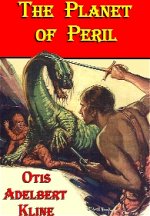 We open up with Robert Grandon, working in the insurance field, bored out of his mind, and dreaming of adventure. Luckily, Grandon fits the bill, and the mysterious Doctor Morgan summons him telepathically and then drugs him unconscious. Well, I suppose it's not the usual way to win friends and influence people, but it works for Morgan.
We open up with Robert Grandon, working in the insurance field, bored out of his mind, and dreaming of adventure. Luckily, Grandon fits the bill, and the mysterious Doctor Morgan summons him telepathically and then drugs him unconscious. Well, I suppose it's not the usual way to win friends and influence people, but it works for Morgan.
When Grandon wakes, he's introduced to Harry Thorne and invited to read a couple of novel length manuscripts, which turn out to be the stories of Harry Thorne, Swordsman of Mars and Jerry Morgan,Outlaw of Mars. The Harry Thorne that Grandon has just met is in fact Borgen Thakkor, previously of Mars, in Thorne's body. Somehow, Grandon swallows the whole thing, and after a few misgivings, volunteers to be catapulted to Venus in a body exchange!
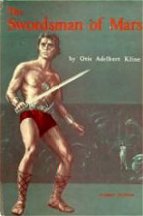
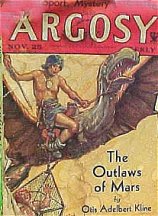
I'll be fair to Morgan, he does tell Grandon that he's going to put him in the body of a gentleman who has been enslaved by a brutal and selfish Amazon Queen. I can sort of see how the guy who is a slave on primitive Venus would want a ticket out. But inexplicably, this seems like a good idea to Grandon. Perhaps it's a kink, who knows.
But anyway, Grandon wakes up as a slave: Sunburned, overworked, wearing nothing but a scarlet breechclout. He can't speak the language, but that's hardly necessary, since he's sent out to the quarries to haul giant slabs of granite or marble around, apparently because someone wants to build a pyramid. This doesn't last. He punches out a guard and heads for the hills. Somehow managing to escape, he runs into a bunch of Venerian hyeanas and gets treed.
Luckily, he's rescued by the only man on Venus prepared to do him a good turn. Vorn Vangel, the Venerian genius who is Doctor Morgan's counterpart has shown up to help him adjust to his new planet. Grandon discovers that his body belongs to Thaddor, Prince of Uxpo, something of a mild mannered fop who had the temerity to �make love� to Queen Vernia. It's not clear whether this was a rape, attempted rape, a seduction gone wrong, a spectacularly bad performance or perhaps Vernia simply bores easily. But whatever happened, Thaddor wound up in the slave pits.
Vangel leads him twenty miles from the quarries. There, they camp out for a week and Vangel teaches him the Venerian language, Patoa, and gives him a few tips. Thereafter, Vangel walks out of the story, returning to Olba, which is on the other side of the planet from Reabon, about 12,000 miles distant.
Luckily, or unluckily for Grandon, he immediately stumbles upon a band of guerillas, who are part of the Uxpo army of resistance, the �Fighting Traveks.� (Turns out that he was in a quarry in Uxpo all along, talk about irony). They're tough enough to live up to a name like that. With a display of martial prowess, Grandon manages to become leader of the band. Then, as his fellow guerillas realize that he's actually Prince Thaddor, he moves up in the world. Thaddor was apparently something of a fop, so Grandon manages to impress everyone with his swordsmanship and leadership qualities. Pretty soon, he's acclaimed as the hero of prophecy.
Unfortunately, Queen Vernia hears of his escape and of the resistance, and decides to put it down once and for all. She raises up an army, heads out to Uxpo and starts kicking ass. Grandon, outnumbered and outgunned, can only organize a retreat. He's cut off from his forces. Trying to track down his men, he discovers that the trail he's following is actually made by a big lizard. The lizard in its turn is following a Reabonian soldier, a boy by the looks of it. Grandon decides to rescue the kid, who turns out to be a beautiful, if short blonde woman: Queen Vernia.
It seems that Vernia had problems of her own, apart from the �being chased by giant lizard� thing, it seems that Prince Desotho is plotting to remove her from the throne, and this military campaign is his excuse to make her vanish. Once she's been gone from the throne for a year, succession will mean he rules Reabon. Thus, as a result of a �rebel attack� Vernia herself is separated from her troops and cast upon her enemy.
Grandon decides to call a truce until he and Vernia can get back to their respective armies. I know, he's obviously a dolt. And to prove it, he decides to cross a river on a giant toadstool, and gets them both swept away into the ocean. They drift for two days, before making land again. Grandon, much like Carson of Venus, confesses that he's lost and without a clue.
They walk along barren country until they come to a cliff. Moving inland, they come to a pool with underwater fruit bearing plants. This, Vernia tells him, is the land of the fearsome Grampits, who, shortly thereafter, kidnap her.
The Grampits are a sort of giant humanoid vampire bat, or flying lamprey. They're about eight feet long, covered with soft mouse-gray fur, they have bats wings for arms, a human torso and legs, clawed feet, an apes head and a leeches mouth with sucker lips and a ring of teeth. Grandon manages to beat off an attack of the creatures and then heads to their colony to rescue Vernia. Along the way, he sees a flying ship from Olba. The pilots land to observe the Grampits and become dinner.
Grandon sneaks aboard the ship, figures out how to use it, and manages to fly into the Grampits colony and rescue Vernia. It's a very Dantean inferno, there's a great big battle, lots of derring do happens. Really, you should read it for yourself.
Anyway, the long and the short of it, is that Vernia and Grandon are flying away, returning to Reabon or so they think and working out peace treaties, if you know what I mean. Yes, peace is breaking out all over between them, when suddenly, they crash into a tree. And what a tree. It seems that they've flown into a gigantic forest of trees thousands of feet tall. And it seems that Grandon has gotten them lost once again, though arguably, its not his fault because his compass was broken.
The flying ship is now disabled, so they're going to have to walk home. The problem is, Vernia tells him, that they're really lost. Trees like this don't exist anywhere inside the Empire of Reabon. In fact, she's never heard of anything like this. They're obviously in some unexplored part of Zarovia.
Grandon decides to explore, to see if there is a way out. But before you know it, he's captured by six legged armoured beings who seem to resemble giant ants. Vernia, showing more presence of mind, climbs to the top of the tree and discovers that she's in a huge narrow valley ringed by mountains. Then she too is captured.
The ant creatures are called Sabits, and resembling colonial insects, they have various castes. They also keep humans as a slave caste within their hive. This is where both Grandon and Vernia wind up, although it takes them a while to get back together. Along the way, they make friends with the local humans, who are a hairy, big boned, low browed, coarse featured lot. Vernia learns that the Sabits breed their human slaves with each other, and that sooner or later, she'll be bread to some healthy slave against her wishes.
Meanwhile, Grandon in another part of the colony plots an escape. Sensibly, Grandon has decided to dig a fifty foot tunnel with his bare hands. Did I mention that he was a bit of a dolt? But he's a lucky dolt, because while digging his tunnel, he falls into a buried chamber and discovers the hidden city of the Albines, a race of men who had been able to dominate the sabits with superior weapons and armour.
Grandon puts on a suit of Albine Armour and finds his way out of the tunnels, just in time to interrupt the villainous Tholto, who is about to take Vernia for his own. As I said, he's a lucky dolt. Before you know it, he's leading a revolt of humans against Sabits, equipping them with the armour from his underground city. Eventually, after a whole pile of derring do and glorious heroics, the Sabits are overthrown. The grateful people name their new kingdom Granterra, after �Grandon of Terra.�
Unfortunately, while Grandon was kissing puppies and righting wrongs, the villainous Tholto has kidnapped Vernia and fled the valley on an underground river. Grandon takes off in hot pursuit with a handpicked squad. Along the way, he falls in the water, has to fight a lizard, meets a tribe of blind cave dwelling humanoids and eventually catches up with Tholto. But its too late, Vernia has escaped and been eaten by some critter or other. Grandon is too depressed about the whole thing to even bother killing Tholto. He has nothing left to live for, bummed out, he decides to tie up a few loose ends by freeing Uxpo.
At this point, the narrative seems to skip ahead a few months, and perhaps a few chapters, because the next thing we know, we're in Reabon and Prince Destho, sitting on the throne, hears a remarkable report of a captured woman resembling the former Queen Vernia found wandering the edges of a great salt marsh on the edges of the Azpok ocean. Her companion is a hairy marsh man named Tholto. Apparently, in between chapters, Tholto has had a change of heart, reformed himself, and pledged his loyalty to Vernia.
Not to be outdone, offstage, Robert Grandon has taken control of the rebellion, overrun the capital of Uxpo, driven out the Reabonians and become a huge problem. Now, its possible that Kline was in a hurry and just wanted to keep things moving, or its possible that the Ace Books edition managed to misplace a few chapters. Who knows. All I know is that everyone has been busy.
Well, Prince Destho, being a weasely kind of guy, decides that he could just have Vernia killed. But it would be better if she agreed to marry him and hand over the Empire all legal-like. Things go Destho's way when Grandon infiltrates the castle, claiming to be a messenger. Of course, Grandon is kind of a dolt, so he's caught in no time, and Destho tortures him until Vernia agrees to his marriage proposal. It seems Vernia is sweet on the big lug.
Outraged, Grandon escapes captivity, slays all around him. Destho flees like a coward. This isn't good though, since Destho is only getting reinforcements. Just then, Grandon's Uxpo army shows up. But its more bad news, since Destho's army starts to slaughter them. Then Grandon's Granterra friends show up, and together, the two armies kick Destho ass. Destho flees to the capital of Reabon, where he prepares to publish the marriage declaration that will make him the legal Emperor.
At this point, out of the blue, a huge sphere appears: A spaceship! Doctor Morgan makes a surprise reappearance, with Harry Thorne/Borgen Thakkor in tow, as well as Vorn Vangel, and an entire fleet of Olban airships. Morgan mentions that the men occupying Thorne and Grandon's earthly bodies have both conveniently committed suicide, and so there's no going back to Earth. Apart from that, they don't have much to do with the plot. Despite the Olban fleet and the Uxpo and Granterra armies, there is no hope of conquering the Reabon Empire. Instead, the succession will happen as per the constitution.
However, just as all seems lost, there's a final twist: It seems that when Destho's back was turned, torturing Grandon, Vernia switched Destho's name for Grandon's. So when the proclamation is read out, Robert Grandon is proclaimed the new emperor of Raebon, and Vernia his wife.
Planet of Peril, I'm told, was originally written in 1922, although not published until 1929. It was followed by Maza of the Moon, and then by Prince of Peril, which featured the parallel adventures of Harry Thorne occurring in the same time frame. Port of Peril came later, and the two Martian novels came in 1933. Oddly, although the Martian novels were clearly published years after Planet of Peril, the novel places them as happening first. I can only assume that Kline revised the opening chapters to mess with the chronology, or perhaps some zealous editor decided he was doing him a favour.
Planet of Peril is hardly Kline's strongest interplanetary novel, in fact, it may share space with Maza of the Moon as the weakest.Prince of Peril and the two Mars books are unquestionably superior.Port of Peril, though flawed, seems stronger. The plot relies a bit too much on coincidences and luck, and on Grandon acting like a lunk at the right times and damn near superhuman at other times, Vernia's character is not well sketched out and there seems little reason for her to fall in love. Characters like Joto appear out of nowhere, and other characters like Tholto go through inexplicable metamorphosis. It feels like there are whole chapters missing.
That said, the writing is clean, it moves along briskly, and it's a better than average piece of work in most respects. Of course, this being Kline, comparisons to Burroughs are inevitable. What can I say? It's a decent, though flawed novel, not as good as most of the Barsoom books, better than some of the Amtor books, inferior to the best Tarzan novels and superior to the worst.
PORT OF PERIL - SYNOPSIS
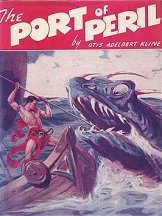 Events seem to be set shortly after Planet of Peril. The book opens with a meeting of the leaders four strongest nations of Zarovia: Grandon of Raebon, the largest and most powerful Empire. Ad of Tyrhanna and Aardvar of Adonijar, the two greatest naval powers, and Zinlo of Olba, the sole aerial power.
Events seem to be set shortly after Planet of Peril. The book opens with a meeting of the leaders four strongest nations of Zarovia: Grandon of Raebon, the largest and most powerful Empire. Ad of Tyrhanna and Aardvar of Adonijar, the two greatest naval powers, and Zinlo of Olba, the sole aerial power.
It seems that there are two items on the agenda:
The yellow people of Huitsen are troubling everyone with their piracy, but no one can strike back because no one knows where their city is. In particular, they've kidnapped Ad of Tyrhanna's younger daughter. Ad's older daughter has married Prince Zinlo of Olba, and his sister is married to Aardvar of Adonijar, so it's a family thing.
Grandon has a score to settle with Mernerum and its prince, Zanaloth. The Mernerum thing is interesting. At the beginning of Planet of Peril, Mernerum is mentioned briefly, when its messengers convey an offer of marriage which Vernia casually dismisses. After that, it doesn't come up again. But Grandon is very angry, to the point of going to war, over some insult or offence that Zanaloth committed on Vernia when she was passing through its territory.
This is a mystery, because there doesn't seem to be any offence committed prior to or within the pages of Planet of Peril, and there doesn't seem to be any time or opportunity to commit an offence between the two novels.
Instead, the most logical construction, is that in the last part of_Planet of Peril_, after Vernia is separated from Grandon outside of Granterra, and before she winds up captured by Prince Destho, she must have passed through Mernerum and been accosted by Zanaloth. There's apparently a small adventure there which we never hear about, except indirectly.
This gives us a geographical clue about Granterra's whereabouts. Mernerum is described as being to the west of Raebon. If Vernia passed through Mernerum after leaving Granterra, then its likely that Granterra is also in the west. However, in Planet of Peril, the Granterran army seems to be able to reach Raebon without impinging on Mernerum.
Of course, this is neither here nor there. Back to the novel. After their summit meeting, Grandon decides to go on honeymoon with Vernia. This suggests that their marriage, and the Planet of Peril must be fairly recent. Even if royal and imperial business delayed their honeymoon, I can't see it going past a few weeks or months, a year tops.
As luck would have it, however, the Huitsen attack the honeymoon party while Grandon is out fishing with his friend Kantar. Vernia is kidnapped by the yellow pirates, lead by Thid Yet and San Thoy.
And an unsavoury bunch they are: Yellow of skin, and with oriental names and culture, they have long arms and legs, pot-bellied bodies, and catlike pupils. Their skins are greasy, they are bald and without body hair (save for the occasional thin mustache), have no teeth (or only a few teeth), and constantly chew Kerra, a narcotic fungus, and spit its juices like tobacco. Bottom line, they're the yellow peril, by way of an Alabama trailer park.
Although its never suggested directly in the novel, the yellow Huitsen seem reminiscent of the Ma Gongi of the Moon. The Ma Gongi, we hear in Swords of Mars, have a colony on Mars, and appear to have also given rise to or influenced the oriental cultures of Earth. So its likely that in the context of Kline's universe, we're looking at yet another Ma Gongi/Oriental colony established on Venus. Obviously, the Huitsen like Earth's Asians, have diverged somewhat from their lunar forebears.
But again, I'm drifting off the novel. Grandon discovers that his wife is kidnapped, and immediately sets sail in pursuit. He's got no idea where the Huitsenni are, but its established that they always sail south, so he heads south zigzagging until he locates the Huitsenni ship.
Of course, things are never easy. While he is stealthily sneaking up on the ship, he sees a Huitsenni drop a large parcel into a small boat and sail away. It turns out that this is the lecherous San Thoy, who, overcome by Vernia's beauty, wants her for himself. So, he's drugged her, dumped her into a lifeboat, and snuck off. Grandon, not realizing how close he's come, proceeds to attack the Huitsen pirate ship.
Meanwhile, San Thoy takes Vernia to his refuge, a small cove on the island of the Valkars. He tries to have a little mattress action, she flees, and they're both captured and enslaved by the inhabitants of the island.
The Valkars, we discover, are humanoid toads. Basically, giant amphibians who walk upright and have manlike builds, the Valkars have language and customs, but prefer to have human slaves do their work. Toadlike, their infants hatch from pods or eggs on the females back and then head for the water. They worship a giant snake called Sistabez and feed victims to it regularly. Vernia is the first human female they've captured, so they get the great idea of breeding her to have more slaves. Unfortunately, Sistabez gets hungry, so at the last minute, Vernia is on the menu.
Luckily, Grandon, following on his love's trail, also reaches the island and rescued Vernia in the nick of time. He manages to enrage the snake so that it takes out its fury on the Valkars, while they make their getaway. The angry Valkars pursue and almost catch the fleeing refugees, but at the last minute, rescue arrives. Alas, they are merely captured once again by the Huitsen pirates before they even get off the island.
Taken back to Huitsen, they're lead through the secret passage between the cliffs. Grandon was actually planning to escape before they got trapped in the forbidden city, but that didn't work out. As the ship comes into port, Grandon and his companion, Kantar escape. Vernia winds up in the royal harem, once again, facing a fate worse than death.
Grandon manages to hook up with the resistance through San Thoy, who apart from his lecherous attempts on Vernia, turns out to be a good guy after all. At one point, Grandon is almost drowned, but he's rescued by San Thoy. Soon, he's in the middle of a plot to overthrow the government.
Meanwhile, Vernia hooks up with a white Princess, Narine of Tyrhanna. You'll recall that write at the start of the novel, we're told that the daughter of the ruler of Tyrhanna, King Ad, has been kidnapped, well, halfway into the novel, she's finally shown up. The Huitsen Emperor also shows up, to have his evil way...
Then things get complicated. It turns out that Vernia has actually been kidnapped for Zanaloth of Mernerum, who wants her body badly. Narine is to be sold off to the Ruler of the Antarctic wastes, which are occupied by the nomadic Ibbits people. But the Emperor, Yin Yin, decides he wants to roll them both in flour and look for wet spots all by himself. The ruler of the Antarctic, Heg, who turns out to be an apelike guy covered in white fur, decides he wants both girls too. They start to argue.
Then Grandon appears and chops Yin Yin's head off. Right behind him, Kantor grabs the first white girl he sees, covers her with a blanket and makes off with her on Grandon's instructions. Unfortunately, he doesn't realize that there were two white girls, so he's accidentally grabbed Princess Narine. But that's okay, because we're overdue for a romantic subplot.
Grandon, meanwhile, is distracted fighting the Emperors guards. The ruler of the Antarctic grabs Vernia and absconds. So once again, Grandon is in hot pursuit. It seems that the interior hinterlands of Huitsen lead directly to the antarctic steppes that the furry people live on, so it's a horse chase all the way. Grandon infiltrates the camp, and when an ice monster attacks, he shoots the Ruler and makes off with Vernia. So far so good. They escape successfully, have an awkward encounter with a giant ice scorpion. Returning to Huitsen, they discover that the death of the Emperor Yin Yin, has only resulted in the perfidious Thid Yet taking the throne. Grandon is sentenced to death.
Elsewhere, things aren't going so well for Narine and Kantar. On the good side, misunderstandings are cleared up, they start off bickering romantically, and the writing is on the wall. It's a bit too fast and rushed, all too often, Kline fails to adequately ground or develop his romances, but what can you do. On the down side, the pirates catch up with them, blow their ship to smithereens and capture them.
Luckily, Zinlo of Olba, who we met in _Prince of Peril_and at the start of the novel, takes advantage of the occasion to show up with his aerial fleet, rescuing our second set of protagonists. They plan an invasion of Huitsen, and San Thoy leads a small fleet to block the gates of the secret passage open.
The invasion hits just as Grandon is to be executed. Moving fast, he grabs a sword and proceeds to hack up Thid Yet and his guards. The Chispok resistance finally makes their move, and with the aid of the invaders, Huitsen is liberated, and everyone lives happily ever after.
After that, there's only a need for Kantar and Narine to declare their love, and for Grandon to exact his revenge on Zanaloth of Mernerum by setting a cunning trap. Mernerum is conquered and Kantar becomes its new ruler. Everyone lives happily ever after.
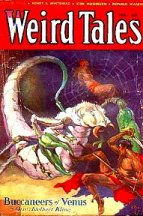 So much for the Port of Peril, also known as Buccaneers of Venus. The treatment of the Huitsen is interesting. The �Yellow Peril� and xenophobia was a staple of the pulp fiction of the time. The orient was mysterious, untrustworthy and ruled by Fu Manchu. It was the closest thing we had to a genuinely alien culture, independent of the west, with its own history and traditions, operating on technical and social levels equivalent to our own. So when writers were looking for an �other� as an enemy, it was a pretty obvious target.
So much for the Port of Peril, also known as Buccaneers of Venus. The treatment of the Huitsen is interesting. The �Yellow Peril� and xenophobia was a staple of the pulp fiction of the time. The orient was mysterious, untrustworthy and ruled by Fu Manchu. It was the closest thing we had to a genuinely alien culture, independent of the west, with its own history and traditions, operating on technical and social levels equivalent to our own. So when writers were looking for an �other� as an enemy, it was a pretty obvious target.
That said, Kline's Huitsen are not a stereotypical racist portrait. Sure, there is a pronounced comic book orientalism going on. The Huitsen are both courteous and ruthless, harkening back to oriental clichés. But Kline does much to redeem them by introducing the �water rat� movement which seeks to reform Huitsen society. The ills of Huitsen, we are shown, are the misdeeds of a small ruling class devoted to piracy, a policy that not everyone agrees with. San Thoy starts out as a villain, is nearly a rapist, but is gradually redeemed by circumstance until he finishes up as one of the heroes. The Huitsen are different, but there's no sense that they are either inferior or inherently evil. Indeed, the novel ends with the reform of Huitsen's government and their acceptance into the community of nations.
Perhaps the biggest disappointment of this novel is the character of Vernia. In Planet of Peril, Vernia was a warrior queen, holding court, exercising the functions of government, crushing rebellions and raising armies. She was a skillful general, a wise and judicious ruler and a brave adventurer. In this novel, she's all but a cipher. Every time she turns around, she's being kidnapped, she faints at least twice and when Grandon battles for their lives in front of her, she can't think of anything to do but stand and watch. It's a weak and stereotypical heroine she becomes, a come down from the flashes of spirit and backbone she showed in the first novel.
Two other critical weaknesses should also be mentioned. The romantic subplot between Narine and Kantar is perfunctory to say the least. For much of the novel, Narine isn't even a character and Kantar is merely Tonto to Grandon's Lone Ranger. Their meeting is late, their romance is rushed and forced, they literally fall in love in the course of an afternoon, while being chased by Huitsen pirates and bickering with each other. The romantic side seems to frequently give Kline trouble in other books, the Vernia/Grandon romance in Planet of Peril is barely plausible, if that, while the Maza/Dustin romance in Maza of the Moon is hardly plausible at all. Only in Prince of Peril did he really seem to get it right.
There are other structural weaknesses to the novel. Characters appear early on, then disappear for much of the book, the Mernerum subplot is alluded to but never developed in any real way.
But having said all that, it's a pretty good novel. Its inherent flaws mean that its not quite on the level of Kline's best books, particularly_Outlaw_ and Swordsman of Mars and Prince of Peril. But its still right up there. Some of the weaknesses of Planet of Peril, such as the reliance on luck and coincidence, are considerably diminished. The writing is clean and energetic, and the whole thing proceeds at a headlong breakneck pace that just picks the reader up and rushes them along. Surprises and plot twists are constant, but not ridiculous. It can easily be placed within the upper ranks of Burroughs adventures. It's a worthwhile read.
A VISION OF VENUS - SYNOPSIS AND DISCUSSION
This is a short story from 1933. Essentially, it opens with Doctor Morgan of Earth, telepathically watching some hapless Venerian, one Lotan, who happens to be a botanist for Olba. Why Doctor Morgan wants to spy on botanists is beyond me.
Lotan is flying around above the Ropok ocean, searching for an island with an edible fungus that's quite valuable. Unfortunately, his flier is damaged in a storm and so he has to make a landing. On the island, he spots the remnants of a wrecked Tyrhanna navel ship, and decides to see if he can help any of the survivors. He follows a set of footprints, and rescues a beautiful girl who is being attacked by Hahoes, a sort of three horned hyaena-wolf creature. Unfortunately, as he's dealing with them, a flying monster makes off with the girl.
Lotan pursues in his airship and rescued the girl. He finds that she's an orphan with a great big castle full of slaves and no one to love her. By happy coincidence, her purse is lousy with the spores he's been looking for, so they're rich. The fall in love and live happily ever after.
Okay, there's not much to this. A few thousand words, a bit of adventure, a bit of romance, it almost seems like the start to an adventure novel. And in fact, that's how a lot of adventure novels start, they just keep adding things on.
Its chief distinction is that it is available on the internet, but apart from that, doesn't add all that much to our knowledge of Kline's Venus. Olba, Tyrhanna, Doctor Morgan, Hahoes, fern forests and giant toadstools are all staples of Kline's previous books. The only really new thing is the �gnarsh� which seems to be a poorly described, leather winged, eagle taloned, man-eating, flying predator fond of making nests on high crags.
THE BIRD PEOPLE - SYNOPSIS AND DISCUSSION
This 1933 short story actually may not technically be a part of Kline's Venus series. However, for reasons set out herein, I'm going to include it nevertheless.
The story is that a large passenger liner is lost mysteriously. Eventually, a survivor turns up with a bizarre story. It seems that they were sailing along, and suddenly, they were accosted by a strange flying globe which fired three coloured rays at them. The Rays lifted the ship from the water, and for a time, the crew lost site of anything. When they regained their vision, they saw they were flying over a strange land whose contours they did not recognize.
Beneath them, they find a rolling plain, and strange duck billed domesticated animals. Looking over the animals, are even stranger creatures. It is a man like creature, covered with brown feathers, and with a large feathered crest on its head. Springing from its back, it possesses rudimentary wings.
The sailors check the stars, and observe a planet with satellites which is definitely Jupiter. They also spot a planet that might be Mars, although it's a trifle off colour, looking almost purple. They also spot a planet rising in the twilight that they identify as Venus. From this, they conclude that they're on Earth, or not far from it.
Of course, the Bird People who kidnap them claim that they're in a parallel dimension. But, there may be another explanation. After all, the only planet they definitely identify is Jupiter. If they're in a parallel dimension, they should possibly see a parallel moon, but it is never mentioned. The identifications of Mars and Venus are tentative, neither planet is quite right... They might possibly be mistaking Earth for Mars and Mercury for Venus, in which case, they're not actually on Earth, but one planet over. They're actually on Venus.
They are brought to the land of the civilized Bird People, their captors. These Bird people are wingless nudists, with feathers at strategic locations and forming head crests. However, although flightless, these Bird People note that there are winged barbarians who can fly.
The Bird People also share their planet, they say, with a singular race of white, animal-derived, humans, who they believe are from another planet, or other dimension, and with whom they are at war.
Their ships are flying globes. Our protagonist hangs about with the Bird People for a time, finding them charming. But behind the scenes, they're sneakily vivisecting the humans and performing experiments. In short, they're clearly lying to our protagonist about their actions and intentions, so I'm inclined to regard everything else they tell him about themselves and their world as potentially untrustworthy. Are they from another dimension? Or merely from Venus? Do they rule their whole world, as they occasionally claim (and occasionally contradict their own claims, when they refer to barbarian flying races), or merely a corner of it?
Eventually, the Bird People show our hero their gladiatorial games, at which the local white humans are put to death. He sees a beautiful Princess, leaps to her rescue, and while they wait for death, the war globes of the white human race attack. Our hero gets catapulted back to Earth.
There are an additional few details that are suggestive of Venus. The flying globes are highly reminiscent of the interplanetary transport machines used by Jerry Morgan in Outlaw of Mars and Doctor Morgan in Planet of Peril. In both cases, the origin of these machines is Venus.
Also, the leading �Bird Man� scientist is Vangar De, a name that seems reminiscent of Vorn Vangel, the great Venerian scientist.
Of course, Kline places no race of Bird men on Venus, in any of his canonical Venus novels or stories.
But interestingly, Burroughs does. Burroughs Venus novels feature a race of bat winged bird men, with feathered head crests and feathers discretely covering genital areas and other body parts, called Angans. And since the Angans appear in 1934 in Pirates of Venus, after Kline's Bird People and Venus novels, Burroughs might possibly have simply borrowed and sandwiched them both.
Now the fit is not exact, but it seems possible that, if we're uniting the worlds of Burroughs and Kline, that the �Bird Men� of Kline's story are actually a flightless race of the Angans of Burroughs stories.
Flightless birds are not uncommon on Earth. Typically, when on large isolated islands without predators, birds will grow large and become flightless. Examples include the Mauritian dodos, the Antarctic Penguins, the Elephant Birds of Madagascar, the Moa of New Zealand, the Emu of Australia, and the extinct Diatrama and Phororacos of the Americas.
So, we might assume that the Angans found a large isolated island, evolved as they settled it, losing the power of flight, and eventually developed a pocket civilization in the northern hemisphere, where they eventually came into conflict with Olba or some other offshoot of Zarovian civilization.
THE GEOGRAPHY OF KLINE'S VENUS
Okay, so how do we work out the geography of Kline's Venus?
Well, first of all, we should acknowledge that there are blank spots on the map. In Planet of Peril, Queen Vernia refers to unexplored and unknown territory unknown to Reabon. Equally, in Prince of Peril, the land of the robot man is unknown. And the lands of the Valkars, Huitsen and Ibbits are also unknown to the civilized nations of Zorovia. So, what does this tell us?
Well, it tells us that the Zarovian nations occupy only a part of Venus. The whole of the planet is not thoroughly explored, there's plenty of blank spots at the edges or beyond their territory. Thus, the Zarovian culture, and the adventures of Grandon and Thakkor cover only a limited geographical subset. There is known Venus and there is unknown Venus.
Beyond that, however, I'm going to be prepared to assume that the Zarovian cultures are not as spectacularly incompetent, when it comes to geography, as Burroughs Amtor cultures. Let's face it, no one could possibly match the Amtor for bad geography. The Amtor believe that their world is an inverted bowl, which is bad enough, but they compound the error by placing the polar regions at the equator, and the equator in the center. This means that the Amtor maps are nightmares, you have to go through an entire forensic exercise to try to unsnarl them and any result will have considerable uncertainty.
Kline's Zarovians at least, seem able to distinguish between north and south, and seem to grasp the notion that the world is round. This saves us a lot of trouble in trying to deconstruct Zarovian geography. While Kline does not oblige us with detailed maps, as Burroughs does, Kline does at least drop some geographical information. What do we know?
Prince of Peril
- Olba is an isolated and independent nation which preserves its independence through a monopoly on air power, but has no dreams of Empire. This suggests that it is an island nation, since no amount of air power would save Olba from an overland invasion. Its Island must be big enough to sustain an advanced culture, thus, larger than Bermuda. But too small to really justify delusions of Empire, thus smaller than Australia. It's probably somewhere around the size of New Zealand, Madagascar, Cuba, Hispanolia, England, Ireland, Newfoundland, etc.
- When Thakkor flees Olba in Prince of Peril, its noted that his flight takes him at least 1000 miles. We're told he has travelled southwest. Thakkor winds up on a land mass, quite close to the city of Adonijar.
- It is specifically mentioned that they are in the tropics or subtropics, because night falls rapidly.
- When Thakkor pursues Taliboz by sea, the voyage takes five days and nights - no miles given, but we can assume a substantial distance traversed. They are travelling on the Ropok ocean.
- Taliboz's flight initially is northeast, towards Olba, but under pursuit, Taliboz is forced to circle around southwest, eventually coming to land.
- Taliboz flees into the interior, the land rising steadily in elevation. This is the land of giant cannibal ape-men. It's not clear if this land is geographically continuous with Adonijar, or if the two are islands or separate. Even if separate land masses, they would clearly be geographically related.
- In the interior, there is a mountain range running roughly north/south. Beyond this is a great marshy lowland, and a second parallel mountain range, running north/south, roughly southwest.
- Following the mountain range southwest, they come to a large sheltered valley, about 25 miles in length, occupied by the Robot Men of Dorovia.
- Escaping from the southern end of the valley, they eventually make it to the coast. From there, Lorali tells Zinlo that Olba and Tyrhanna are roughly equally distant, and that Olba is in the north, Tyrhanna is in the south.
- We never get to Tyrhanna, so we're not sure if it is on an island, is a part of the land mass they've been traveling across, or is a part of a separate land mass.
Planet of Peril
- Reabon is an empire ruling over sixteen kingdoms, suggesting that it is a land based empire occupying continuous territory. This puts it on a continent sized land- mass.
- Mernerum is mentioned as an empire to the west of Reabon., but we never actually go there. Later references in Port of Peril suggest that Mernerum may be on the same land mass as Reabon.
- The southernmost of Reabon's possessions is Uxpo, a mountainous country which borders the Azpok Ocean.
- Grandon and Vernia drift out of Uxpo into the Azpok ocean for a few days, coming to the Island of the Grampits. The Island is due south of Reabon.
- Thereafter, they try to fly home, but get lost. They travel in an unknown direction, probably west (inferred from Port of Peril), and wind up in unexplored territory in a mysterious valley of giant trees. This valley is probably on the same land mass as Reabon, probably in the interior, since later, Grandon returns to Uxpo, Vernia to Reabon and an army marches from the valley to Reabon.
Port of Peril
- Reabon the largest empire with the largest army, Olba the sole air power, and Tyrhanna and Adonijar the two great sea powers have a loose alliance.
- There are twelve known nations in Zarovia. This would include the four already mentioned, Mernerum, and Granterra. The other six are not identified.
- It appears that Reabon has reached the limits of its expansion. Other nations are forming coalitions against it. There is a reference to a war between six nations and Reabon, in which Tyrhanna came to the assistance of Reabon. Also, at the end of the novel, Reabon has conquered both Mernerum and Huitsen, but does not absorb either state into its Empire, suggesting that its allies aren't prepared to see it expand.
- In the Azpok ocean, a great distance south of Reabon, is the island of the Valkar, amphibian men. Its probably a fair sized island from the descriptions, since it hosts a large population and complex geography. Mernerum is able to hide a large fleet behind it.
- The Valkar Island seems to be midway between Huitsen and the northern land mass. The Huitsen use it as a way station, and Mernerum uses it as a meeting point for the Huitsen.
- Much further to the south, in the southern hemisphere is Huitsen. The area of Huitsen is blocked by huge cliffs, through which a secret entry allows access to the hidden port city. Despite being behind the cliffs, the Huitsen port sits on a large inland sea or lake. Thousands of ships are observed, and the city is built out onto the water so that people can fish from their houses.
- Huitsen is connected geographically to the land of the Ibbits. This is described as an antarctic waste, a land of eternal snow, or snow covered mountains. The Ibbits are able to provide 10,000 zandars (a horse-like creature). This implies that their herds are much, much larger, since they don't seem particularly impoverished by the trade. Also, the presence of wild predators indicate that they haven't taxed the local ecology to the limits of its carrying capacity. Thus, the Huitsen/Ibbits lands must be comparatively large, perhaps on a continental scale.
The Bird People and Vision of Venus
- These two works don't offer much further to our geographical knowledge.The Bird People seems to be set on a large island. Vision of Venus is set on a small island.
Okay, so, take them all together, and what do we have? I read two oceans, three principal continental masses, one temperate in the north, one equatorial, and one sub-polar in the southern hemisphere. There are several islands of various sizes.
On Kline's known Venus, there are two major principal oceans. The Azpok and the Rapok. The Empire of Reabon, as well as the island of Grampits and probably the lands of Vernerum and Granterra, the Island of the Valkars and the nation of Huitsen all border the Azpok. Most notably, Reabon is north of the Azpok. On the other end, the Azpok also reaches far down the southern hemisphere into Huitsen. This implies a �north south� orientation for the Azpok ocean.
Of course, if you've got a big north south orienting ocean, you'll have strong temperature differences between pole and equatorial regions, which give you strong currents and lots of storms and bad weather. True to form, Vernia in Planet of Peril, refers to the Azpok as the ocean of storms and mysteries.
There appears to be a large continental mass in the northern hemisphere in temperate latitudes. Reabon, of course, as an Empire comprising sixteen kingdoms, is a big chunk of territory. But Reabon also seems connected by land to Mernerum and to the valley of the Sabits, named Granterra.
Reabon, is clearly in a temperate zone. So, its in a temperate zone in either the northern or the southern hemisphere. However, its most southern province is Uxpo, which suggests that the bulk of the kingdom is somewhat further north. If in the southern hemisphere, this suggests that the balance of Reabon is orienting towards the tropics. But there's a problem: Uxpo and Reabon borders on the Azpok, which leads towards Huitsen and Ibbits, which is definitely in the temperate/subpolar regions of the southern hemisphere. This means that if Reabon is in the southern hemisphere, its right on top of Huitsen. This doesn't work, if they're that close, there's no way Huitsen could avoid discovery. Other lands, like Adonijar and Tyrhanna are halfway around the world from Huitsen, or so we are told, but they are well known to Reabon. The implication is that Adonijar and Tyrhanna are apparently closer and more accessible to Reabon than mysterious Huitsen. So, the most likely interpretation is that Reabon occupies a continental mass in the temperate zone of the northern hemisphere.
Meanwhile, Olba, Adonijar and Tyrhanna, as well as the lands of the ape-men, and the valley of the Robot men seem to be around the Rapok. In particular, the lands of Adonijar and Tyrhanna as well as the ape men, appear to be all part of a continuous continental mass to the south of the Rapok, which is located in the tropics.
Adonijar is a sea power, but it appears that the territory to the south and west of it is land. Accordingly, Adonijar is, politically, economically and militarily, orienting north. So it may or may not actually be in the northern hemisphere, but its sphere of influence or interest extends definitely in that direction.
From there, they can sail north to Olba or South to Tyrhanna. Well, all right, let's look at it this way. Olba is in the north of the coast. So assuming Adonijar is in the equatorial region, then Olba has to be in the northern hemisphere. If Adonijar is in the southern hemisphere subtropics, then Olba, still north, has to be either equatorial or northern hemisphere.
We don't know too much about Tyrhanna, except that it appears to be to the south of Olba and Adonijar. It can be reached by sailing south, which means that like Adonijar, its orientation must be towards the north and the northern hemisphere.
It's possible that the Ape-man lands, Tyrhanna and Adonijar, are all on separate land masses or giant islands of course. But if they're not a continuous land mass, it seems likely that they are geographically related as an archipelago of sorts. The land mass, or archipelago complex seems to be oriented along the equator, though parts of it run north and south, so that the shoreline (or a major section of shoreline) orients southwest or northeast.
So, the picture that we get are of at least two major �continental� scale land masses (or archipelagos). One is in the temperate region of the northern hemisphere. One is in the equatorial region, sloping northeast. There is a third �continental� or subcontinental land mass deep in the southern hemisphere. Meanwhile, there's a relatively placid northern hemisphere ocean, running approximately east and west, and another very volatile ocean which runs north and south, crossing the southern and northern hemispheres.
The Rapok appears to be in a tropical or subtropical region and seems to be orienting roughly east and west. Thus, the Rapok seems to have a less volatile and dangerous reputation than the Azpok. The Rapok and the Azpok oceans are connected, by the way, since the Adonijar and Tyrhanna fleets can sail from the Rapok to the Azpok.
The lands of Huitsen and Ibbits are stated to be definitely in the southern hemisphere, in the temperate and sub-polar regions. The territory of the Ibbits, in particular, must be fairly huge, since they can supply Ibbits with ten thousand zandars, a horse-like creature from their herds. Now, arctic or subarctic environments are not the richest areas around, so if you have a herd of 10,000 horse sized creatures, you're looking at a good chunk of territory. But note that the Ibbits can part with 10,000 zandars without bankrupting or impoverishing themselves. This suggests that their herd is much larger, 100,000 to 1,000,000 beasts. During Grandon's brief excursion into the region, he encounters two major predators. This tells us that the sub-antarctic steppes are not completely and thoroughly domesticated. The Ibbits and their Zandars are only a part of a larger ecology, not the whole of it. All of this indicates that the Huitsen/Ibbits territory must be fairly huge, on the area of hundreds of thousands to millions of square miles.
How are we doing so far?
Unfortunately, as we've noted, Kline, unlike Burroughs, supplies no maps. Its possible that he drew them up as part of his reference works, but they have not come down to us. Although his books supply a lot of detailed geographical information, we seldom spend time on distances or relating one location to another. And often, the information is too local or general to be of much help.
Olba, the Valkar Island and Island of the Bird People are all likely fairly big islands. But we've got no idea of just how big they are, or what their relationships are to other geography. On the other side of the scale, Kline is quite good at describing the transitions to uplands and lowlands, he mentions marshes, salt marshes, swamps and rivers, but while that's helpful in getting around the neighborhood, it doesn't exactly provide for GPS, if you know what I mean.
So, consequently, at the end of the day, we've got only fairly rough relationships. There are, however, a few very distinctive geographical features that might catch our eye:
- The twin mountain ranges in Giant Ape-man land. Basically, running northeast/southwest, there seem to be two parallel sets of mountain ranges with a relatively narrow marshy lowland between them. This would be located on what may be the equatorial continent.
- The valley of Dorovia, of the Robot Men. Roughly to the south of Giant Ape-man land, it seems to be a an extension or ripple in the twinned ranges. Located on the equatorial continent.
- The valley of the Sabits, also known as Granterra. Surrounded by impassible mountain ranges, and marshes beyond that, with a river leading to the coast. Located on the northern continent.
- The Inland Sea or Great Lake of the Huitsen. A body of water separated from the Azpok by formidable cliffs, with a single, possibly artificial passage. The body of water is large enough to float a sea fleet of thousands of ships and a major port city. Located at the north of a sub-antarctic continent.
So, this is our geography for Kline's Venus, or Zarovia, as his characters call their world.
Can we find them?
MATCHING ZAROVIA
The first step, of course, is to find some decent maps of Venus. For our efforts, what we want are some good topographic maps. So, allow me to repeat the relevant sections of Unravelling Amtor.
I would refer the reader to a series of topographical maps:
The Bright Map: This one is the most richly coloured and has the benefit of giving many of the features discernible names. So, it's a good reference map, the highland or �land� areas are generally called �Regio,� while the lowlands are generally called �Planitia.� Unfortunately, its handicap is that it is a bit too richly coloured, making it a bit awkward to discern.
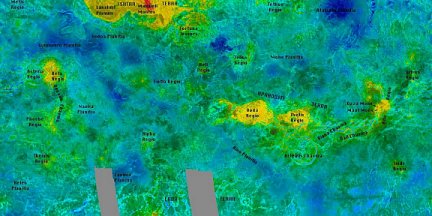
The Green/Blue Map: This one is much better, particularly in allowing us to distinguish broad lowlands in blues, which would represent oceans and seas, from broad highlands, mostly in greens, which would represent islands and continents. With respect to this Map, I think that it comes closest to being a useful model for both Carson's Amtor and Kline's Zarovia, with the exception that the sea level is a little low. There are areas which are obviously Islands that are tenuously connected to mainland. Elevate the sea level a little, and those areas be come true Islands and Amtor and Zarovia comes into focus.
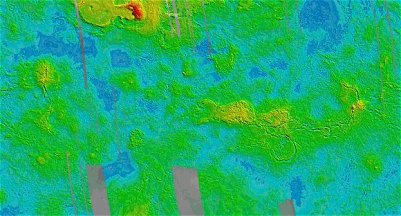
Then there's Ralph Aeschilman maps, which I like to call the Dirty Brown Maps. Primarily this provides hemispheric views and the greatest amount of detail, and it provides the most detailed naming of sites. On the downside, the dirty brown/yellow colouration and the narrow colour scale means that its just not as much fun. Hey, I'm shallow, I admit it.
Viktor�s Map: The most interesting is Viktor�s, which sets out the surfaces of both Venus and Mars with interactive topography. Literally, you can adjust the sea level to determine what the shape of land will be at various levels. On Viktor�s adjustable topographic map, we can readily see the different extremes of Martian geography, and experiment with how that world would have looked with oceans of varying depth. We can do the same thing with Venus, although Venus's range of altitudes is much less. Still, Viktor�s map, particularly around the range of 450 to 500 meters, gives us a fairly good look at Amtor/Zarovia.
Are we all set? Excellent, let's go.
The first thing we'll notice as we look at these maps is a northern continental mass, Ishtar Terra, which sprawls across northern and temperate latitudes. You can also see it on the Alpha hemisphere of the Dirty Brown map. It divides loosely into two lobes. A relatively low eastern side called �Fortuna Terra� and a more rugged western end known as �Lakshmi Planum�. Between the two is a ridge of ferociously high (for Venus) Mountains called Maxwell Montes.
Now, looking at Ishtar Terra as a land mass, the logical conclusion is that the western end is probably warmer and better watered, and therefore, probably fairly rich, temperate and fertile. There is sea access on three sides from the south, which means that the area is likely very accessible to rains, and protected from northern air currents. This is the likely site of the Empire of Reabon.
Uxpo becomes the lands at the tip of the Fortuna Terra peninsula.
On the western side, the highlands are likely to have thinner air at higher elevations, thus they'll be colder, dryer and less fertile. However, the midland areas in the far west will also be fertile. This is probably the region of Mernerum. Rich and large, but not as rich or as large as Reabon.
Finally, the countryside up there is rugged enough, that there are several areas we might be able to pin the valley of the Sabits on. Meanwhile, we can assume that the interior hinterlands, particularly the rugged highlands are mostly unexplored unoccupied territory, as far as the Zarovians are concerned.
Next up, we'll note Aphrodite Terra. We paid a lot of attention to Aphrodite Terra when doing the Amtor exercise. Essentially, Aphrodite terra is a sprawling, scorpion shaped continental mass, straddling the equator. When dealing with Amtor, we noted that the southern side was fairly well defined, but that the continent had a long ridge or series of mountain ranges down its center, which would act as a barrier to northern exploration by the Amtors. Its also going to block southern exploration by the Zarovians.
Dealing with Amtor, we found that Carson had in fact accidentally flown into the north, and had wound up temporarily in the vicinity of the lake of Japal. And we did find a feature that would match that lake.
So let's take a look at the continent again, this time from a Zarovian perspective. Obviously, its big enough to contain Adonijar, Tyrhanna, and the Cannibal-Apeman coasts. But where, precisely?
We need to look to the eastern end of the continent, to the �tail� of the �Scorpion�. Here, the continent abruptly shifts, rising to the north east. It's best observed in the dirty brown map, for the Kawelu/Helen Hemisphere, but there's a pretty good view on the blue green map. The areas we'd be looking at are described as �Atla Regio� which is marked by a winding north/south mountain range that slowly turns east west in its southern sections.
Most notably here, the central mountain range contains a series of chasms or valleys between them, such as �Ganis Chasma� running north/south, and the lower southwest running �Dali Chasma�. These central valleys mean that the mountain range is actually divided into two parallel ranges, with a lowland between them. In short, we've got a good match for the lands of the giant Cannibal Ape-men, and for Doravia, the valley of the Robot Men.
Of course, Ganis Chasma may not be the actual valley beyond the ape men, and Dali Chasma may not be Doravia, the valley of the Robot men. But the thing is that the range possesses these and other dividing valleys, so its likely that this is the right general area for these sorts of features. The two "chasma�s" are too far apart, so its more likely that both the apeman valley and Doravia are adjuncts or sections from Ganis Chasma.
The two major cities or nations, Adonijar and Tyrhanna will be located on this continent, on either side of the ape-men and doravia. The north of the apes will be Adonijar, and to the south, or perhaps southwest, apart from placing them on the coastlines, its hard to locate them with any greater certainty.
The only clue we've got is Lorali's contention, in Prince of Peril, that Tyrhanna is about as equally distant as Olba, from her and Thakkor's exit point to the coast. If I had to make arbitrary decisions, I'd probably locate Adonijar at the top of the Scorpion's tale, on or near the area of �Nokomis Montes� on the dirty brown map. Tyrhanna would be in the area of �Miralaidji Coronoa� at the southern reach of the sea.
Olba, meanwhile, is most likely the highland known as Ulfrun Regio on the brightly coloured and on the dirty brown maps. It's a highland area to the northeast of the scorpion's tail, and therefore in about the right area and the right region. It would also make for a fairly dandy sized Island, so it fits the bill quite nicely.
The sea region above the scorpion continent of Aphrodite Terra, including Ulfrun, would obviously be the Ropok Ocean, which runs roughly east west, and would be fairly placid.
There is a glitch in that the Ropok Ocean would seem to border right up against Ishtar Terra, and particularly the area we've identified as the Empire of Reabon (Fortuna Terra). But you know how sailors are, its clear that the Ropok and the Azpok oceans join or merge, so the boundary between them may be rather arbitrary.
Certainly below the western side of Ishtar Terra, there is a large lowland which crosses into the southern hemisphere. On the east side, its bounded by Aphrodite Terra, the scorpion continent. On the west side, its bounded by the complex of highlands or regios, including Asteria, Beta, Themis and Phoebe, which on our Amtor discussion, we identified as Anlap. So this region would be the famed Azpok ocean.
At the southern extremity of the Azpok, we have the rugged highlands of Alpha Regio, which leads to a highland or land mass called Lada Terra, extending towards the south pole.
Now, here's where it gets really interesting. When we were discussing Amtor, we identified this area, and this land mass as the 'continental' leg. Essentially, it is a spur of land or continental land which joins connects to the equatorial continent described by Burroughs in his map of Amtor, and connects that equatorial continent to the southern polar region. Essentially, in a very nice coincidence, it seemed to conform very nicely to Burroughs Amtor map, and to deconstructions of that map.
The only glitch, was that it seemed to contain an inland sea, not disclosed on Burroughs maps. I tried to get around this by noting that the Amtor culture wasn't really all that good at penetrating continental interiors, and that their map making and geographical skills were pretty poor. I'm still standing by that.
But let's take another look at this inland sea, or this complex of small inland seas. What we may have here is the hidden sea or lake, and the area of the yellow sea of Huitsen! The location would be somewhere to the east of Alpha Regio.
And of course, Lada Planum, to the south towards the polar regions gives us the land of the Ibbits, an area more than large enough to allow them to raise their vast herds of Zandars.
Moving north, there's a highland area near Eistla Regio, identified as Sif Mons and Gula Mons that seems to be in the right intermediate position to serve as the island of the Valkars.
And as for the Bird people? Big Island, temperate conditions, isolated? There are a couple of nice, relatively mid-sized, very isolated highlands, called Tellus and Annanke Regios (or Tesseras) which could fit the bill quite suitably.
In short, we can comfortably fit Otis Adelbert Kline's Zarovia onto the topography of Venus.
MATCHING KLINE'S ZAROVIA TO BURROUGHS AMTOR
A Question of Respect
The first question is should we? Isn't it, in some way, disrespectful for both Kline and Burroughs to radically sandwich their two fictional worlds together. Both Burroughs and Kline built interconnected universes.
With Kline, for instance, his Martian and Venus books feature interlocking characters, so that the adventures of Jerry Morgan on Mars and Robert Grandon on Venus are clearly taking place in the same cosmos. Maza of the Moon refers to events that are also alluded to in Swordsman of Mars. Kline's universe has its own history and continuity. So, in some sense, it may be more respectful to look at and treat Kline's universe as standing alone and on its own terms.
Burroughs too interconnects all of his series. Tarzan crosses over with the Pellucidar series in Tarzan at the Earth's Core. Pellucidar crosses with Barsoom, when the Gridley Wave is used to transmit the stories of adventures. The Moon Maid begins by referencing John Carter and communications with Barsoom. Carson attempts to reach Mars and winds up on Venus, and even the Caprona series refers to there being life on Mars.
In short, is there any need, or any justification for attempting to merge two rich and distinct fantasy universes. Probably not.
Except, of course, that its fun, and if it can be done, it's a neat hat trick.
The other side of the coin, obviously, is that neither of these men were working in ignorance of each other. Kline had obviously read, and was a fan of Burroughs Barsoom novels. Indeed, he made a direct reference to them in the opening of Prince of Peril. Its very hard, therefore, to divorce Kline's Mars books from the Barsoom series.
Burroughs began writing his Venus books after Kline had written his Venus books. So in that sense, if we accuse Kline of imitating Burroughs Mars, we might, with as much or more justification, accuse Burroughs of imitating or stealing Kline's Venus. The series are that similar. Particularly, Robert Grandon's penchant for getting lost is reminiscent of Carson, and Princess Lorali's breezy attitude is suggestive of Duare in Lost on Venus.
The two writers are tightly interwoven, not only by their respective and competing publishing histories in the '20s and '30s, but also by the apocryphal legends of competition and rivalry which have grown up between them, and the identification and marketing of Kline as a sort of Burroughs counterpart. It becomes almost impossible to separate them. So why not look at their respective worlds as an interlocking set, its clear that within their own writing, they were not afraid to make connections, and its clear that they were aware of and perhaps took inspirations from each other.
And there is a large sense that they actually were working on the same worlds. The Mars of the period between 1890 and 1940 was a very well defined landscape in popular imagination and in the science of the day. Venus was perhaps less well defined. But still, there was a very strong popular image of Venus as a young wet world, filled with tropical jungles and oceans. The picture that evolved was partly a contrast with Earth and Mars. So when Burroughs and Kline wrote their Venus stories, they were drawing from the same world, a sort of archaic "Pulp Venus." So perhaps, we should try to return these works to that same world.
And as I said, its fun to try, and it will make a good trick if we succeed.
How is the Fit?
Actually, is is quite easy. Burroughs Amtor cultures are all based in and around the southern hemisphere, with only the outermost fringes extending into the northern hemisphere. Meanwhile, Kline's Zarovian cultures are clearly clustered around the northern hemisphere, with only one protrusion into the southern regions.
So it's a big planet. North is north, south is south, and never the twain shall meet. Kline and Burroughs have each left a hemisphere blank for the other, and there's no reason why the Amtor and Zarovia cultures couldn't occupy the same world.
Essentially, there's practically no overlap. There's no place where for instance, Kline's Tyrhanna and Burroughs Havatoo are occupying the same apparent geography. Rather, each man's geography applies to distinctive and complementary different sections of the planet. You can fit the two series of books onto the same planet like a jigsaw puzzle. They just fit together.
I find myself wondering if this was a conscious decision on the part of the writers. Did Kline look for an empty part of Barsoom to set his stories in? Did Burroughs reciprocate the courtesy and deliberately locate his Amtor in the southern hemisphere, well away from Kline's Zarovian nations? It does seem that way. Whether that's the actual case, or whether its simply happenstance we'll probably never know.
What about Contact?
Well, except.... They are two active seafaring cultures? How is it that they're not stumbling over each other. Could the two really exist without contact? And if they did come into contact, wouldn't that have consequences?
In �Anthropology on Amtor� I've argued that the Amtor cultures are a monoculture, there's literally no other civilization, and so they've grown increasingly decadent and ineffective. They're ripe for collapse, and in fact, are undergoing a series of internal collapses or revolutions.
Why haven't the active Zarovians overrun the decadent Amtors?
Geography and Demographics
There are major geographical barriers keeping the two cultures separate. The equatorial continent, Aphrodite terra, girdles a fair chunk of the planet, and its quite clear that neither the Zarovians nor the Amtors have had much success penetrating deep into the continent.
Meanwhile, the southern �leg� continental region, that connects the equatorial continent to the polar region, also acts as a barrier for the Amtor on one side, and the Zarovians and Azpok on the other. My impression, from Burroughs maps, and deconstructing the geography of Amtor, is that most of the Amtor population and emphasis is on only one side of this continental leg�. The Huitsen, who keep to themselves and are essentially a �hidden� nation, are on the other side of the leg.
So, the bottom line is that geography means that there are only a limited set of opportunities for the Zarovians and Amtor to come into contact.
Finally, the evidence seems to be that both the Zarovian areas and the Amtor areas are thinly populated. In both series, heroes journey into the continental areas and find them sparsely settled and mostly wild.
In my Amtor articles, I theorize that Venus surface is mostly basalt, and that the territory resembles the Canadian shield. Thus its difficult for widespread agriculture to take hold. This seems true for the Zarovian surface, which is mostly wild fern forest and vegetation. This also means that exploration will often tend to be fruitless. Bountiful rich lands are hard to come by, and usually occupied by hostile primitive species or predators. Thus, traders are motivated to stick with what they know, and explorers are usually taking a fairly big risk.
Due to relatively low populations, both sets of societies explore only poorly outside their immediate areas, preferring what they know. Hence, there aren't a lot of chances for the Amtor and Zarovian cultures to meet up.
So, between geographical barriers, low population density you won't have a lot of ongoing contact between the Zarovian and Amtor cultures.
Technology and Weapons
The technological levels of the two societies are quite similar. They're both non-industrial societies, which travel the seas primarily through wind power. But of the two, the Amtor are clearly the more advanced, with better fuel and better engines.
In particular, the Zarovians weapons are outclassed. The Zarovians use Torks and Mattorks, essentially gas powered projectile throwers of great range and potency. That's pretty good. But the Amtor, or at least the heavy duty Amtor cultures, including the warring nations of the Anlap interior, and places like Havatoo, Vepaja and Thora, have a variety of disintegrator rays. Well, face facts, ray guns beat pistols. Any conflict between an Amtor ship and a Zarovian ship will find the Zarovians getting acquainted with the ocean bottoms. A war between an Amtor and Zarovian nation will see the Zarovians get their butts kicked.
In short, although the Zarovian cultures may be younger and more aggressive, and the Amtor cultures may be static and decadent, the Zarovians are not going to have an easy time pushing into Amtor lands.
Universal Languages?
Is there evidence of at least some contact? Actually, yes, a case could be made. For instance, consider the fact that both the Amtor and Zarovian cultures have a universal language. The Amtor language, in fact, has extended beyond the Amtor culture, and has been adopted by Myposans (amphibian men), Brokols (plant men), Angans (bird men), Voyargans (amoeba men), Nobargans (ape men) and pygmies (monkey-men).
The Zarovians also have a universal language, but it's a bit more complex. For one thing, the Zarovians universal language seems foreign to them. Each city has its own language, or residual language. The Zarovians common tongue, Patoa, is not a product of Empire, but rather, appears to be a trade speech, commonly used but not driven by politics or cultural dominance. Raebon is the biggest most powerful empire, Olba the most advanced, Tyrhanna the dominant sea power, but none of these seem to be the source or the inspiration for the linguistic conformity. So, here's the problem, there doesn't seem to be any clear source or origin for the Zarovians common language.
And more puzzlingly, the Zarovians common tongue is spoken outside the Zarovian culture. It is used by both the Huitsen and Ibbits in the southern hemisphere, and by the ape-men of the equatorial continent. On the other hand, it isn't universal in the northern hemisphere, both the insect-like sabits, and the amphibian Valkars have their own language.
So what are we to make of this? I think that the best theory is that the Zarovians common language, Patoa, is actually the Amtorian language, which has spread through seafarers and through diffusion across land areas, well beyond the range of the Amtor culture itself. It's likely that the Zarovians are evolving a divergent dialect of Amtorian, but they're probably all speaking the same language.
It's also likely that the Amtor cultures that Carson finds in the northern hemisphere are themselves influenced by the Zarovians.
Thor and Thorther
When I wrote Anthropology on Amtor one of the things I suggested was that as a society ossifies and becomes stagnant, it becomes vulnerable to foreign ideas and foreign religions. Looking at the history of Earth, we see a constant slippage of ideas, technologies, languages, religions and social theories in from the hinterlands. The Roman Empire, for instance absorbed Christianity from a poor obscure province. The Muslim world began in an out of the way desert city. The central societies are always static and hostile to new ideas, they always seep in at the edges.
I theorized that the Amtor culture, being largely alone on Venus, had no place for new ideas to originate from. Instead, it would become steadily more decadent and stagnant, far past the point where it would normally collapse, simply because there was nothing out there to give it a push. Eventually, these societies would become so frail that they'd literally disintegrate into social revolutions, as we saw in Korva, Havato and the Thorist revolt. In that sense, I saw Carson as a one man revolution, bringing an arsenal of revolutionary new notions to Amtor.
I'll stand by that. But this leads to a question. If in fact, Kline's Zarovian cultures are sharing the planet with Burroughs Amtor cultures... And even if there's hardly any contact. Shouldn't there be some possibility of ideas from Zarovia infecting the increasingly stagnant and vulnerable Amtors? Would there be any signs of this?
In fact, there is one very telling clue. The Zarovians venerate a great prophet named Thorth. Like the Amtor, the Zarovians don't seem to have much use for religion. There is no mention of god or gods, of spirits, demons or angels, there's no prayer and no worship. Instead, Thorth seems to have been a �confucian� prophet, offering advice for living, and perhaps for afterlife. Thorth mostly shows up in oaths, �By Thorth's bones� that sort of thing.
Intriguingly, the Amtor have, in the last few hundred years, been wracked by a philosophical movement called Thorism, after another prophet named Thor. Is there some relationship between Thorth and Thor? Between Thorism and Thorthism?
Arguably, what we may be seeing here is a near unmistakable case of philosophical contamination. There are precedents. In the 1800's, Christian missionaries brought Christian religious ideas and belief to China. Eventually, this resulted in one Chinese fellow declaring himself the younger brother of Christ and leading a religious movement which nearly overturned the Chinese government. The Taiping Rebellion was the bloodiest conflict in the 19th century, killing over forty million Chinese. This is the most dramatic, but there are other examples of Christianity being introduced into marginal societies and mutating into almost unrecognizable cults, such as Mormonism.
So, assume an insular, monolithic Vepajan empire, which has little interest in contact with Zarovians. Still, there is contact with Zarovians, someone hears all about the prophet Thorth. The ideas of Thorth catch on in the underground and among lower classes, percolating slowly. Finally, some young renegade decides its time for a new prophet, renames himself Thor, and refashions Thorth's philosophy into something more neatly tailored for both revolution and Amtor culture. Voila, you have the equivalent of a Taiping rebellion on Venus!
Indeed, if the ideas are floating around, the revolutionary movement of Mephis in Korva may also be derived either from Thorth or Thor. A lot of the social dislocation that Carson observes may well be related, not just to the decay and stagnation of Amtor society, but also to the infection of Zarovian ideas.
Related to this, we notice that the Amtor societies which are most stable, the inhabitants of the Anlap plains are also the most isolated from possible Zarovian contact. Other stable societies, like the rather primitive societies like Japal in the northern hemisphere, probably have some degree of Zarovian contact and are therefore inoculated.
It's worth noting that Burroughs was certainly aware of Kline's Venus books. He probably read them, or at least looked through them. They were, after all, being published in the same magazines. So there's a good chance that Burroughs was aware of Thorth.... And if he was, then his use of the names of Thor, Thorists and Thorism seems highly suggestive of either a conscious or unconscious connection.
Amphibians and Angans, Biology is Relativity
Finally, to wrap it up, I'll note that both Kline and Burroughs seem to feature related or similar alien races.
Kline, in Prince of Peril, gives us Valkars. Amphibian toad men, humanoid creatures who keep human slaves and run a haphazard civilization. Meanwhile, Burroughs in Lost on Venus introduces us to the Myposans, another race of humanoid amphibians. The two races aren't that close, the Myposans pass for human, the Valkars are definitely giant toads. The Myposan young begin as fish from eggs laid in the water. The Valkars eggs are kept on the females backs, and hatch at least partly land adapted. Still, real amphibians have remarkable diversity, so the fact of two races of amphibians is rather suggestive. Also peculiar is the fact that Burroughs Myposans are bearded, like Kline's Zarovians, but unlike Burroughs own Amtors. Are the Myposans influenced by Zarovian culture?
Then, there are the bird people. Burroughs in his novels, gives us Angans. Winged flying men who sport crests of feathers on their heads and other parts of their bodies. Kline, also gives us Bird People of various sorts. Of course, on this one, I'll admit I'm going a little far afield. To be perfectly honest, Kline does not explicitly set his Bird People story on Venus. Rather, his protagonist is told that he's on a parallel Earth. Nevertheless, the actual evidence may be ambiguous enough, and other evidence compelling enough, that we might arguably set the Bird People story on Venus. If this is the case, then Kline introduces us to a race of flightless Angans and further, acknowledges the existence elsewhere of winged flying Angans.
There are also a few other suggestive overlaps. Robert Grandon in Planet of Peril, blunders into a giant forest with trees thousands of feet tall. Carson Napier in Pirates of Venus blunders into a similar titanic forest on the island of Vepaja, and then later, encounters another titanic forest. Hence, both Kline and Burroughs acknowledge occasional stands of super-trees. Of course, because Venus was popularly considered to be a lush primitive jungle world, the notion that they'd each write supersized trees may not be remarkable. It could easily be an independent invention... Or at least, a not unreasonable borrowing.
Both of them report sea monsters larger than ocean going ships. Again, perhaps not unreasonable, considering the beliefs about what Venus would be like. In addition to being a jungle world, it was also thought to be a wet ocean world.
On the other hand, both Robert Grandon and Carson Napier encounter wolf-like, pack running, three-horned predators, Kazars in Napier's case, and Hahoes� in Grandon's. In each case, the predator has two horns above its eyes, and one horn between the two. Apart from that, there are other resemblances. The hahoes are described as having hyaena-like bodies, heavy scales (feathers?) and are black with mottled yellow spots, and make a laughing noise. The Kazars are smaller, dog sized, have stiff feathers (scales?), beaks and make a cackling noise. Hmmm... Obviously not the same species, but there are enough potential overlaps to suggest closely related species. Certainly, the resemblances seem remarkable.
Both Carson Napier and Kline's Borgen Thakkor encounter Venerian lions. Kline's creature is called a Marmelot, and is described as a fearsome feline as large as a draft horse, with six inch fangs and a mottled orange scaly hairless hide. Burroughs Tharban has huge fangs and claws, stiff bristly hair, and a reddish hide with white stripes. Not identical, but roughly similar creatures, both modeled on African or Asian big cats.
And of course, both series feature giant ferocious lizards, gigantic snakes, and belligerent herbivores. There's a loose correspondence of plants and monsters.
So, what does all this give us? Well, its hardly proof that one was copying the other. Giant snakes, amphibian men, flying men, giant trees, huge sea monsters and other features are all reasonable extrapolations from a primitive jungle world flush with life. The resemblances between Kazars and Hahoes is a little too remarkable. But by and large, most of this can be judged to working from a similar �source world.�
But on the other hand, the various loose overlaps between Burroughs' and Kline's Venus certainly makes it easier for us to consider both as being on the same world. As far as playing the game goes, it makes it feasible for us to fit them together. Each biological correspondence, loose or tight, helps us to tie the two worlds just a little tighter together each time.
References to Overlaps
Finally, if we look to the books themselves, there are teasing hints from both Burroughs and Kline, that imply that there's more to their worlds than we've seen, and that perhaps, one might indeed sail from Zarovia to Amtor.
In Pirates of Venus, while examining the maps and geography of Amtor, Carson is told that both the polar and equatorial regions contain strange cultures and strange races of men. A clear hint that the Amtor culture may not be universal. Certainly, this allows room for the Ibbits of the southern polar region as well as the Zarovians of the northern hemisphere.
Meanwhile, in the Port of Peril, its mentioned that the Huitsen city is packed with slaves from every race on Venus. Considering that in Kline's books, the only human races we encounter are the Huitsen and Zarovians, this itself is a hint that there's more to Venus than we've seen.
Were the two men really referring, howsoever indirectly, to each others works? Its unlikely in the case of Kline, since his Venus books were all written well before Burroughs did his series. On the other hand, its just possible that Burroughs was making a reference.
The most likely explanation, however, is simply that each of these men was making sure they had lots of elbow room, should there be scope for further or additional adventures, strange lands and stranger peoples.
But having done so, they've sort of opened up the empty room for us to play this game, haven't they?
Anyway, I hope you've enjoyed this little diversion.
